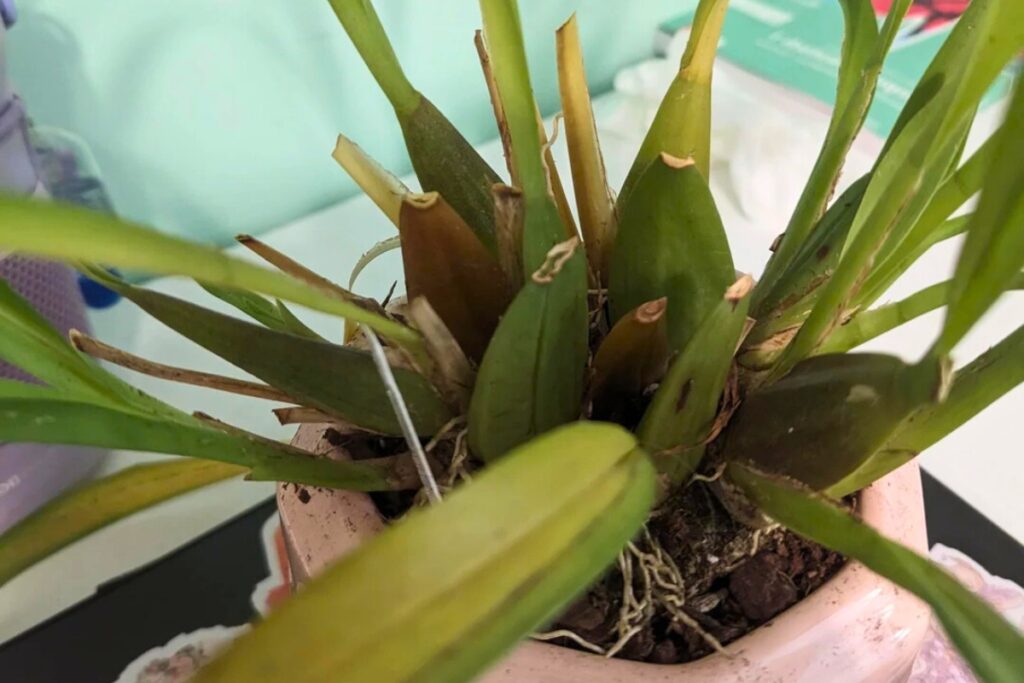If you’re noticing unusual changes in your Oncidium orchid, you’ll want to act quickly to identify and fix the problem. These stunning plants send clear distress signals through their leaves, pseudobulbs, and roots, but knowing which symptoms point to which issues isn’t always straightforward. While some signs like yellow leaves might seem obvious, others can be tricky to interpret – and using the wrong solution could make matters worse.

Contents
Common Visual Signs of Stress in Oncidium Orchids
While Oncidium orchids are generally hardy plants, they’ll display clear visual indicators when experiencing stress. You’ll notice yellowing leaves, wrinkled pseudobulbs, or brown leaf tips as primary warning signs. Root discoloration, changing from silvery-green to dark brown or black, signals potential rot issues.
Watch for unusual spotting patterns on leaves, which often appear as circular brown patches with yellow halos, indicating fungal problems. Your orchid’s flowers might drop prematurely, or new buds might blast (die before opening) when under stress. The pseudobulbs may also become shriveled and soft, rather than maintaining their typical firm, plump appearance.
Environmental Factors That Trigger Orchid Distress
Several key environmental factors can quickly push your Oncidium orchid into distress. First, improper lighting conditions, particularly exposure to direct afternoon sun or deep shade, can cause leaf damage within 24-48 hours. You’ll want to maintain bright, indirect light for 12-14 hours daily.
Temperature fluctuations beyond 15°F between day and night, or sustained periods below 55°F or above 85°F, will trigger stress responses. Poor air circulation, especially in humid conditions above 70%, creates a breeding ground for fungal issues.
Incorrect watering patterns, such as letting roots sit in water for over 30 minutes, can lead to root rot and eventual plant decline.
Three distinct water-related problems commonly plague Oncidium orchids: overwatering, underwatering, and poor water quality.
You’ll spot overwatering when roots turn mushy and brown, while leaves become yellow and limp. Let soil dry between waterings, typically 5-7 days, and guarantee proper drainage with 1/4-inch holes in your pot.
Underwatered orchids display wrinkled, leathery leaves and dried-out pseudobulbs. Water thoroughly when the top inch of medium feels dry, usually every 4-5 days during growing season.
Poor water quality shows up as brown leaf tips and mineral deposits. Use filtered water below 200 ppm in mineral content, or collect rainwater for best results.
Disease and Pest Stress Indicators
Disease and pest problems in Oncidium orchids produce distinctive warning signs that you’ll need to catch early. Watch for small brown spots on leaves, which often indicate fungal infection, while sticky residue on stems points to scale insects or mealybugs. If you notice yellowing between leaf veins, spider mites might be the culprit.
Black, mushy areas at the base of pseudobulbs suggest bacterial rot, requiring immediate removal of affected parts. You’ll also want to check under leaves weekly for signs of thrips – silvery scarring and distorted new growth are telltale indicators. Inspect flowers for small holes or ragged edges, as these typically signal orchid weevil activity.
Recovery Techniques for Stressed Oncidiums
Restoring stressed Oncidium orchids starts with a careful assessment of the plant’s overall condition. Check for discolored leaves, damaged roots, and dehydrated pseudobulbs before proceeding with treatment.
Move your orchid to a spot with 60-70% humidity and temperatures between 65-80°F. You’ll need to trim away dead roots using sterilized scissors, then repot in fresh orchid mix. Water thoroughly but allow the medium to dry slightly between waterings.
For pest-stressed plants, treat with neem oil every 7-10 days. If fungal issues are present, apply a copper-based fungicide and reduce watering by 30%. Most Oncidiums will show improvement within 3-4 weeks of corrective care.
